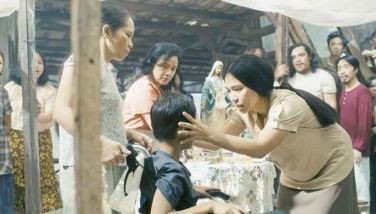Death minus the morbid thoughts
Maybe I’ve established a reputation through the years for being thorough, which is why I’m often asked to judge screenwriting competitions sponsored by different film organizations.
The task can be fun — but mostly tedious. Fun — if the entries are promising. Tedious (which is often) — if the material has nothing new to offer and should never have been submitted to the screenwriting contest in the first place.
But tedious or fun, I studiously go through every line and very neatly write down my comments to serve as guide on deliberation day. (The judges usually have a meeting and discuss the merits of the entries worth translating on the big screen.)
When Tony Tuviera’s APT Entertainment decided to finance the Directors’ Guild of the Philippines’ Sine Direk project, a package consisting of six films (the recently-exhibited Fuschia and the soon-to-be-shown Agaton and Mindy, Dukot, etc.), I was tapped to go over tons and tons of scripts in December 2007 and to my very pleasant surprise, most of the entries in competition were substantial and had a lot of promise.
The first script on the pile that I picked up had the title Ded na si Lolo. I had no idea what it was all about. But as soon as I got to the fourth page, I was laughing all by myself in my study. It was about death, all right — actually rituals for the dead — but done in comedy, minus the morbidity. I did not bother to write down my comments anymore. I had too much to say — all of them good — and I would have run out of space. I just put one big check on the first page and made mental notes.
When the Top 6 were chosen, I wasn’t surprised that Ded na si Lolo made it to the list. But I didn’t hear anything much about it anymore until I read in the papers that it was ready for exhibition.
Now, came my worries. You see, there are scripts that are good on paper, but somewhere along the way when it gets transported to the big screen, the material suffers — or is not followed at all by the director. Worse, the producer dictates his inputs and they end up with a hodgepodge of a film.
Fortunately for Ded na si Lolo (and luckily for the viewers), it turns out to be even funnier when it was made into a film. Written and directed by Soxie Topacio, it sticks basically to the material, but with lots of improvements even.
The movie casts Dick Israel, Elizabeth Oropesa, Gina Alajar, Roderick Paulate and Manilyn Reynes as siblings who all panic when they are told about the death of their father. The last death in the family was seven years ago — when their mother died — and there is much confusion again. Add to that the shock they go through — and there is mass fainting and hysteria among them. To the rescue always is the grandson BJ Forbes, who has with him wads of cotton and a bottle of ammonia to revive his aunts from their fainting spells. He also serves as the film’s narrator.
All throughout the movie, we see a panoply of the do’s and don’ts of Filipino superstitious beliefs when death visits a family: Don’t sweep the floors (just don’t clean the house — period) when an immediate family member passes away and has yet to be interred, the feet of the deceased shouldn’t be toward the door while lying in state in the casket, the rosary clutched by dead person should be broken so that no other family member follows him/her in the next life soon, paper bills should be inserted in between the fingers of the deceased during the wake and that should bring good luck to the living person who will invest the money, etc.
Actually, this enumeration of superstitious beliefs about funerals and funeral services had been done in another local film — Pamahiin — but it was given to viewers like a mere list of what to do and what not to do when there is death in the family. And then, of course, there was the superior Crying Ladies, but that was basically about Chinese funeral traditions.
Ded na si Lolo is different. Everything about it is Pinoy. Anyone aware of the funeral rites or beliefs about death practiced in the provinces (no, I’m not talking about the Igorot or Muslim rituals for the dead — they have different customs) will see a lot of familiar scenarios in this movie. Actually, even here in Metro Manila many of those practices are also followed, especially if the wake is done at home and not in mortuary chapels where there are rules imposed.
What is wonderful about how Ded na si Lolo is presented on screen is that there is nothing distasteful, disrespectful, depressing or even morbid about it. Credit goes to Soxie Topacio, who offers nothing but a very engaging material and excellently staged scenes. He doesn’t waste any moment — each one is entertaining, riotous at most times.
Ded na si Lolo is basically a comedy — one of the funniest I’ve seen. It is the laugh-out-loud type that is best enjoyed with family and friends. No joke falls flat and that is a rarity in local movies. Topacio apparently studied each scene in the movie to make sure it works well with the audience and for that he deserves a standing ovation.
The film, however, also has its touching moments because this is also about family and sibling relationships. The scenes showing the fights among sisters are quite familiar and yet in the end, they’re still family. But truly heartwarming are the sequences involving Perla Bautista, whose character is important in the film, except I can’t tell you what she is there because that will spoil your viewing pleasure.
Of course, Perla Bautista being Perla Bautista she delivers a fine acting job — and so does everyone else. Oropesa’s comedic timing is perfect. Manilyn Reynes’ is even 10 times better here than in One Night Only where she was voted Best Supporting Actress by the Metro Manila Film Festival jurors only last December. Gina Alajar may have been identified with drama (she is one of the greatest), but I saw her comedic skills even way back in the Ishmael Bernal comedy Pabling, where she plays a cameo role as the provinciana girlfriend of William Martinez flirting with the good-looking bus conductor. Here in Ded na si Lolo, you see how easily she shifts from comedy to drama and back like she is a faucet that can be turned on and off. Even Dick Israel has his fine moments as the eldest in the brood.
The scene-stealer, however, is Roderick Paulate, who shows up in his father’s wake wearing a glittery red long evening gown. His subsequent scenes are even more hilarious and you miss the days when he was doing his comedies with Maricel Soriano and later as Kumander Gringa, Binibining Tsuperman and other gay roles he portrayed in the late ‘80s.
Ded na si Lolo actually brings together all the best elements a movie can offer. It is one film about the dead that is so full of life and laughter.
- Latest
- Trending






























